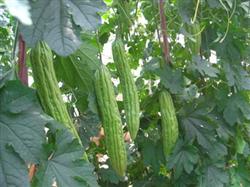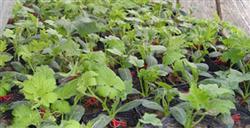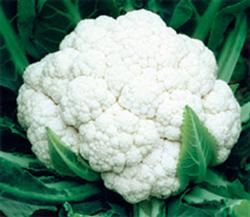Cultivation techniques of balsam pear in greenhouse

The high-yield and high-benefit cultivation techniques of balsam pear in winter warm plastic greenhouse selected the winter warm greenhouse with good lighting and strong heat preservation as the horticultural facilities for off-season cultivation of balsam pear, compared with cucumber, towel gourd and zucchini, balsam pear requires higher light intensity, higher temperature and poor resistance to low temperature and weak light. The lack of light in the seedling stage will reduce the cold resistance of balsam pear, and the lack of light in the fruit period is not conducive to photosynthesis, which is easy to cause falling flowers and fruits and slowing down the rate of fruit expansion. It is difficult for balsam pear to germinate below 13 ℃, stop growing below 12 ℃ at seedling stage, suffer cold injury for more than 2 hours when less than 10 ℃, and freeze injury for more than 4 hours when it is less than 8 ℃. Therefore, when balsam pear is cultivated in the cold and cold period of winter and spring by using winter warm greenhouse (solar greenhouse) in northern China, the winter warm greenhouse with high lighting rate, rapid warming and good thermal insulation must be applied. The winter warm greenhouse is required to meet the following indicators: 1. The greenhouse surface angle is in the best range, that is, the best greenhouse angle range is equal to the local geographical latitude minus the red latitude of "the Winter Solstice" (- 23 °27'). Minus the parameter of 33 degrees 35 degrees. For example, the optimum range of canopy angle at 38 degrees north latitude is 38 °- (- 23 °27')-33 °to 35 °= 26 °27' to 28 °27'. With this kind of shed surface angle, even when the sun height is the lowest "the Winter Solstice", the solar projection angle of the light transmission surface of the front slope of the greenhouse is 5557 degrees (that is, the incident angle is 35,33 degrees), and the light transmittance of the greenhouse film is more than 82%. 2. The wall and back slope of the winter warm greenhouse should be earth-built to meet the thickness of the wall of the winter warm greenhouse. Because the volumetric heat capacity of dry soil is 2.5J / cm 2.1 ℃, which is 2000 times that of air volumetric heat capacity 0.0003 cal / cm 2.1 ℃. Therefore, the wall not only plays the role of cold prevention, but also has the function of heat storage. The winter warm greenhouse with large wall thickness has more heat storage and strong heat preservation, which can effectively slow down the temperature drop in the greenhouse at night, so that the minimum temperature in the greenhouse at night will not be too low. It can prevent the occurrence of "cold injury" and "freezing injury" of crops in the greenhouse. The thickness of the soil wall of the Shouguang winter warm greenhouse should be: the local maximum permafrost thickness plus 50 cm. For example, in severe winter, where the maximum permafrost is 80 cm, the thickness of the greenhouse wall should be 130 cm. Two layers of plastic film on the back slope are filled with hay and straw mud, and its thickness should be 1x3 of the thickness of the wall. 3. In the greenhouse temperature regulation, it can reach the heat preservation standard for temperature-loving vegetables. Under normal covering and heat preservation and other temperature management conditions, the absolute minimum temperature (night) in the greenhouse in severe winter is not less than 8 ℃, and the time below 10 ℃ is short (less than 2 hours). Generally, the temperature in the greenhouse can be controlled above 12 ℃ at night. The temperature in the shed can reach above 18 ℃ an hour and a half after the grass is uncovered in the morning, and it can reach more than 32 ℃ in the case of no ventilation at noon on a sunny day in cold winter. When the grass is covered in the afternoon (around 16:00 in winter), the temperature in the shed can be maintained at 21: 22 ℃. The winter greenhouse which meets the above requirements of increasing temperature and heat preservation standard is suitable for off-season cultivation of balsam pear.
- Prev

Cultivation and seed collection of balsam pear
15-20 days before sowing, deep ploughing and ploughing, combined with ploughing, 3000 kg-4000 kg of rotten barnyard manure per mu, and 15 kg-20 kg of ternary compound fertilizer. The soil and greenhouse were fully sterilized by sunlight exposure and high temperature greenhouse after drying the field for 7-10 days and then sealing the greenhouse for 5-7 days. After holding the ground flat.
- Next

Integrated control of diseases and insect pests in balsam pear
The waterlogging tolerance of cauliflower is poor. When planting cauliflower in rainy areas and under the environment of high groundwater level, the technical measures of deep trench and high chamber should be taken to facilitate drainage, which is the key to the success of cauliflower cultivation. Cauliflower also avoid continuous cropping, the previous crop to melons, eggplant fruits, legumes and vegetables are appropriate, should choose fertile.
Related
- Where is it suitable to grow horseradish in China? it is expected to see the middle altitude horseradish in Alishan.
- How to prevent tomato virus disease reasonably? (Control methods included)
- Many people like to plant towel gourd on the balcony. What are the main points of this method and management?
- What crops can chili peppers be mixed with?
- Fertilization techniques and matters needing attention in Tomato
- What are the grafting techniques for peach seedlings in spring?
- Harm and control methods of root swelling disease of Chinese cabbage
- What are the pests of sweet potatoes? How to prevent and cure it?
- Symptoms, causes and Control methods of navel Rot in Tomato
- The cause of "Cucumber rotten bibcock" in Farmers' planting Cucumber and its Control Plan

